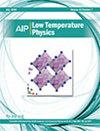隧道磁性约瑟夫森结中反向邻近效应的证据
IF 0.8
4区 物理与天体物理
Q4 PHYSICS, APPLIED
引用次数: 0
摘要
磁约瑟夫森结(MJJs)是一类特殊的混合系统,其中拮抗相关性共存,从而为弱超导、超导自旋电子学和量子计算的发展提供了一把钥匙。迄今为止,对 MJJs 存储特性的研究主要是针对液氦温度下的数字电子学和自旋电子器件。在量子电路的工作温度下,S/铁磁体(F)界面的超导体(S)中会产生磁序,即反向邻近效应(IPE),从而导致 MJJs 中的磁场模式发生显著变化。在这项工作中,我们分别对在铌和铝 JJ 布局中插入强铁磁层的隧道 MJJ 的磁行为进行了比较研究。对比分析验证了温度、S/F 耦合系统的基本缩放能量以及 S/F 界面透明度的关键作用。这项研究指出,在设计工作温度远低于 4 K 的隧道 MJJ 时,IPE 是需要考虑的一个关键方面,因此从混合超导量子结构的角度来看也是如此。本文章由计算机程序翻译,如有差异,请以英文原文为准。
Evidence of the inverse proximity effect in tunnel magnetic josephson junctions
Magnetic Josephson junctions (MJJs) are a special class of hybrid systems where antagonistic correlations coexist, thus providing a key for advances in weak superconductivity, superconducting spintronics, and quantum computation. So far, the memory properties of MJJs have been mostly investigated in view of digital electronics and for spintronic devices at liquid-helium temperature. At the operating temperature of quantum circuits, a magnetic order can rise in a superconductor (S) at the S/ferromagnet (F) interface, i.e., the inverse proximity effect (IPE), thus leading to a significant modification of the magnetic field patterns in MJJs. In this work, we have carried out a comparative investigation of the magnetic behavior of tunnel MJJs with a strong ferromagnetic layer inserted in the layout of both Nb and Al JJs, respectively. The comparative analysis validates the crucial role of the temperature, the fundamental scaling energies of S/F coupling systems, and the transparency of the S/F interface. This investigation points out that the IPE is a key aspect to consider when designing tunnel MJJs operating well below 4 K and thus in the perspective of hybrid superconducting quantum architectures.
求助全文
通过发布文献求助,成功后即可免费获取论文全文。
去求助
来源期刊

Low Temperature Physics
物理-物理:应用
CiteScore
1.20
自引率
25.00%
发文量
138
审稿时长
3 months
期刊介绍:
Guided by an international editorial board, Low Temperature Physics (LTP) communicates the results of important experimental and theoretical studies conducted at low temperatures. LTP offers key work in such areas as superconductivity, magnetism, lattice dynamics, quantum liquids and crystals, cryocrystals, low-dimensional and disordered systems, electronic properties of normal metals and alloys, and critical phenomena. The journal publishes original articles on new experimental and theoretical results as well as review articles, brief communications, memoirs, and biographies.
Low Temperature Physics, a translation of the copyrighted Journal FIZIKA NIZKIKH TEMPERATUR, is a monthly journal containing English reports of current research in the field of the low temperature physics. The translation began with the 1975 issues. One volume is published annually beginning with the January issues.
 求助内容:
求助内容: 应助结果提醒方式:
应助结果提醒方式:


